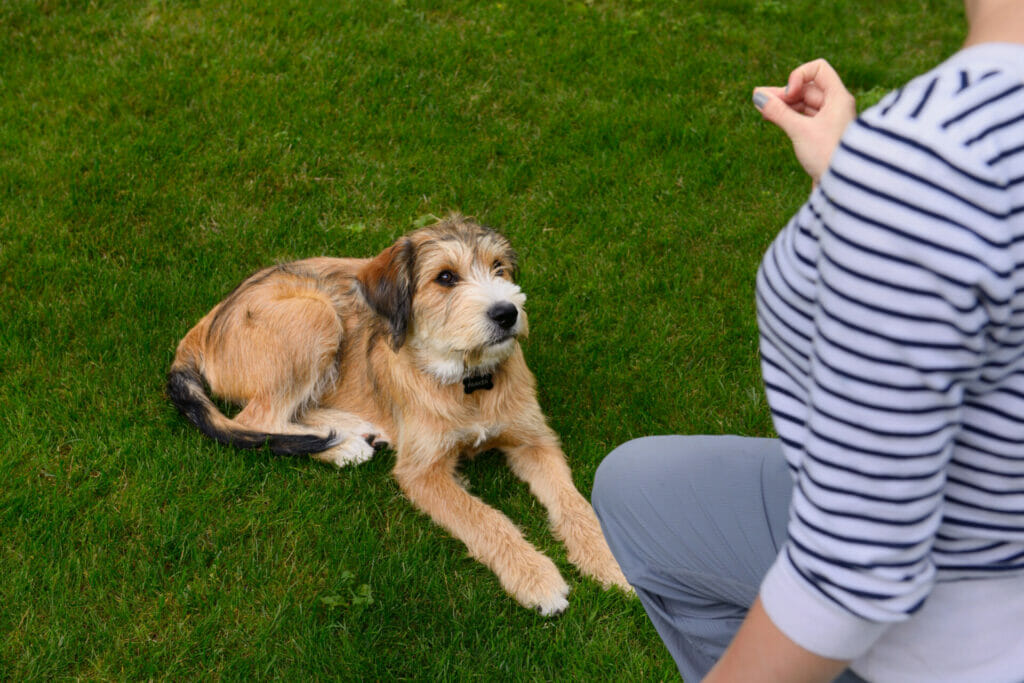As pet parents, it’s helpful when dogs know how to sit, stay, and lie down. These three skills are foundational skills that come in handy in daily life. Though easiest to train puppies, a dog of any age can learn the commands and benefit from the mental enrichment. We’ve compiled a few tips & tricks to help you teach your dog the commands (or reinforce the commands they already know).
Make Learning Fun
When teaching your dog, make it fun for them. It’s important to use positive reinforcement so the new skills and behaviors are enjoyable. Positive reinforcement training utilizes play, toys, and treats to reward dogs for behaviors we like.
If your dog gets confused or doesn’t “sit” when asked, avoid punishing your dog. This just means your dog isn’t fluent with this skill yet. Perhaps your dog is overstimulated and distracted by their surroundings or maybe they just need extra reinforcement. Use any oops moments as a learning opportunity to set your dog up for success in your next practice session. For example, decrease the difficulty and practice somewhere less distracting. Slowly building back up to more challenging environments.

How To Teach Sit
Sit is a basic obedience cue for dogs of any age and size. To teach your dog “sit”, start in a quiet area of your home without many distractions. You’ll also want to have many small pieces of treats your dog is excited about. Tip: if your dog isn’t very food motivated, try a training session before their breakfast.
Steps For Teaching Your Dog “Sit”
Step 1
Get your dog’s attention with a treat.
Step 2
With your dog’s attention on the treat, lure your dog’s nose up and back (towards their tail). As the dog’s nose follows the treat, their body follows. As your dog’s head goes up, their bottom will go down.
Step 3
When your dog goes into a sit position, immediately praise your dog and give your dog the treat. Repeat steps 1-3 several times until your dog consistently goes into a sit stance.
Step 4
Next, introduce a verbal cue of your choice (e.g. “sit”) right before your dog goes into the sit position. Then praise and treat.
Step 5
As you practice, you’ll be able to phase out the treat lure and just use the verbal cue to “sit”. Be sure to continue to praise and treat your dog when they go into the sit position.
Step 6
Once your dog understands sitting in a quiet, low-distraction environment, you can start to practice your dog’s sit skills in more distracting areas, like while out on walks. Tip: once their a pro, you can also switch up the reward. Consider using toys or even just petting your dog after they do what you ask!
How To Teach Stay
Everything You’ll Need For Training
All dogs benefit from learning to stay. Start the training in a quiet area inside your home. Dogs are naturally curious, staying in an area with minimal distractions. To teach stay, you’ll want many small treats to reward your dog.
Steps For Teaching Your Dog “Stay”
Step 1: Ask your dog to sit. Next, hold your hand up as a visual cue and pick a verbal cue, like “stay.” After two seconds, praise and treat your dog. Treat your dog when they’re still sitting so they understands the rewarded behavior. Build this skill slowly, just a second or two at a time at first, to make sure our dogs stay successful.
Step 2: Repeat this over many practice sessions and slowly increase the time you ask your dog to stay. The goal isn’t to see how long your dog can stay. Instead, we want to ensure your dog understands the foundations of the skill before adding duration.
Step 3: If at any point while practicing, your dog gets up and breaks the stay, just bring your dog back where they had been, ask them to sit, and stay again. Ask your dog to stay for a few seconds, then praise and release your dog quickly, so the session ends successfully. The next time you set your dog up for a stay, ask your dog to stay for a slightly shorter period.
Step 4: Over the next several practice sessions, continue to build up the amount of time your dog can hold a stay. You can also introduce distance. Take a small step from your dog after they start the stay command. Return to your dog and praise and reward your dog in the sit position before releasing them from the stay.
Step 5: When your dog consistently understands how to stay in your house and other low-distraction areas, introduce the cue in more distracting areas, e.g. on walks and in parks. Be sure to keep your dog on a leash while you practice in case your dog gets up from their stay.
How To Teach Lie Down
Everything You’ll Need For Training
To teach your dog to lie down, you’ll need lots of treats to use while training. Practice teaching your dog in quiet areas with minimal distractions. Make sure that you are practicing somewhere comfortable. If your dog doesn’t like to lay on hard floors, teach this cued behavior on a blanket or dog bed.

Steps For Teaching Your Dog “Down”
Step 1: Get your dog’s attention with a treat. Lure their nose down towards the ground and then slightly forward. As a dog’s nose follows the treat, their body naturally goes into a down position. Praise and treat your dog.
Step 2: If your dog struggles with following your treat lure into a down, you can start with your dog in a sit. Then, get your dog’s attention with the treat and lure them into a down position.
Step 3: Repeat over multiple practice sessions. When your dog is consistently following the treat lure into a down position, start to introduce a verbal cue of choice like “down” or “lay” right before your dog’s body touches the ground.
Step 4: When your dog consistently goes into the down position when cued, you can begin to phase out the food lure into the down position and instead just use your verbal cue to down and reward your dog with a treat when they lay down.
Step 5: When your dog can do the “down” cue in your home with low distractions, you can practice your “down” cue in your yard, while out walking, and in other areas with more distractions.




















